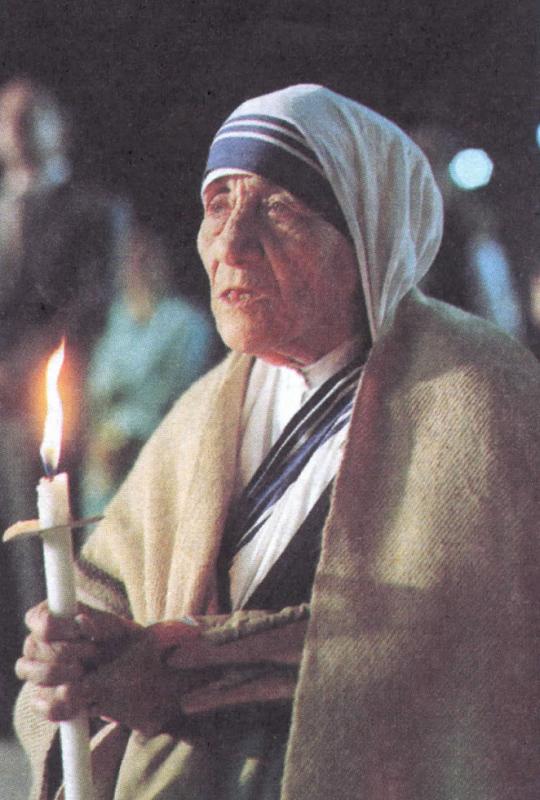Mother Teresa Says No To Death Penalty
By John Dear SJ
 In the spring of 1988, while I was teaching in Scranton, Philadelphia, the state officials announced that Pennsylvania would carry out its first execution in decades. People across the state, nearly all Christian, supported the scheduled murder. “What we need is someone like Mother Teresa to intervene for us,” I said to a friend, a monsignor who worked at the diocesan office. “Not many people know this,” he confided, “but I’ve led several annual retreats for her. I’m sure she would help.”
In the spring of 1988, while I was teaching in Scranton, Philadelphia, the state officials announced that Pennsylvania would carry out its first execution in decades. People across the state, nearly all Christian, supported the scheduled murder. “What we need is someone like Mother Teresa to intervene for us,” I said to a friend, a monsignor who worked at the diocesan office. “Not many people know this,” he confided, “but I’ve led several annual retreats for her. I’m sure she would help.”
Saintly interventions
I called the office of the Governor, a widely respected Catholic, and asked if he would receive an appeal from Mother Teresa on behalf of the condemned man. One day before I was going to contact Mother Teresa, a stay of execution was granted. Over the next few years, I arranged Mother Teresa’s intervention on behalf of death row inmates on eight occasions. Each time, she eagerly offered her support and the prayers of her community in an effort to stop killing and end the death penalty.
In early 1990, while I was studying at the Jesuit School of Theology in Berkeley, the State of California was preparing to execute Robert Harris, who had brutally murdered two young brothers earlier in San Diego. While no one supported his unimaginable violence, and while my friends and I wished only for healing and peace for his victims’ family, we did not want the killing to continue. Many friends organized demonstrations, vigils, letter-writing campaigns, lobbying efforts and prayer services in an effort to stop the murder of Robert Harris.
Over the private line
 I called the monsignor. “Do you think Mother Teresa would be willing to help us? And if so, how can I reach her?” “Of course she would want to help,” he replied. “Here’s her private phone number. I will be praying for all of you.”
I called the monsignor. “Do you think Mother Teresa would be willing to help us? And if so, how can I reach her?” “Of course she would want to help,” he replied. “Here’s her private phone number. I will be praying for all of you.”
Nervous, I dialed the long number. Halfway around the world Mother Teresa picked up the phone in her office. “Hello,” she said in her heavy, unmistakable, Albanian-Indian accent. I introduced myself, told her the situation and asked if she would be willing to help us.
“What exactly did Robert Harris do?” she asked. I told her, then proposed that she speak with the Governor of California, George Deukmejian, by phone in the next few days before the execution and ask the clemency. “Yes I will,” she said, “and I will ask all the Sisters at the Motherhouse here inCalcutta to pray for the Governor.” She spoke of her visit a few years earlier to San Quentin’s death row. On the way out that day, she told the guard, “What you do to them, you do to God.”
What would Jesus do
I called Governor Deukmejian’s office and told them of Mother Teresa’s plan to call. On Monday evening, March 26, 1990, Mother Teresa spoke briefly with the Governor. I called her back immediately to find out what happened, intending, as she agreed, to announce her message to the 20 reporters gathered at the front door of our Jesuit house.
“Did you speak with the Governor?” I asked. “Yes. He started talking about how he had to do this, that this was the law.” “What did you say?” I asked. “I just said, ‘Do what Jesus would do.’”
No arguments. No statistics. No invocation of sin or immorality or injustice. No lecture. No angry denunciation. Just: “Do what Jesus would do.” She cut right into the heart of the matter. “That’s all I said. He talked again about how it was in the state’s hands, so I repeated what I said, ‘Do what Jesus would do if He were in your position.’”
Prayer brigade
“We have to pray,” she continued. “We all have to pray so that he gets the grace and the courage to do what Jesus would do. Pray hard. Get as many people to pray for courage for him. Get everyone in the country to pray. And then, we have to respond to his decision with love and compassion. And keep praying for the family of the victims, too.” She asked me to call her again with any news and promised to help anytime.
The next morning, The Los Angeles Times carried a cartoon depicting Mother Teresa in one corner, speaking on the phone saying, “Do what Jesus would do if Jesus was in your position,” and the Governor in the other corner, on the phone asking, “What would Pilate do if Pilate were in your position?” Miraculously, a California judge intervened a few days later and a stay was issued.
Only love
Two years passed. A new governor, Pete Wilson, who campaigned on a pledge to resume executions, set another date for Robert Harris. Most Californians supported his tough-on-crime stance. Despite eloquent opposition to the death penalty from the Pope, the US bishops and Mother Teresa, over 80% of all Catholics supported executing people. Again, Mother Teresa repeated her message. “Do what Jesus would do,” she said. Alas, Governor Wilson washed his hands of the case, and Harris was killed. I called her with the news. After expressing her grief, she said, “God sees only love. God sees the love that we put into what we do.” She thanked all those who tried to save his life.
My friend in death row
A year later I received an urgent call. My friend Billy Neal Moore, a death row inmate in Georgia whom I had visited and with whom I had corresponded for years, was to be executed in a few days. Billy had been on death row longer than anyone else up to that time. He and a friend got drunk one night, robbed a liquor store and killed its elderly owner. The next morning, he wept and begged forgiveness of his victim’s family. He spent his years on death row praying, studying the Scriptures and counseling other inmates in Jesus’ way of nonviolence.
I flew to Georgia to be with Billy. We organized prayer services, press conferences, demonstrations and vigils. Mother Teresa spoke on the phone to the chairperson of the Georgia Board of Pardon and Paroles, which has the power to grant clemency before an execution. Mother Teresa promised that her community would keep a running prayer vigil for clemency. Meanwhile, Billy sent a message from prison, urging us to be sure that we grant clemency in our hearts to all those who have personally hurt us. Otherwise, he said, we cannot expect the God of clemency to take us seriously and answer our prayer.
Clemency for the clement
Several hours before the scheduled execution, the victim’s family members appeared before the board and pleaded for Billy’s life, saying that killing him would not bring their relative back, nor would it end the killing or ease their pain. Forgiveness and clemency were the only way to healing.
In a historic, near-miraculous decision, clemency was granted. Several months later, Billy was quietly released from prison. Today, he ministers to prisoners and teaches Jesus’ way of love.
War against killing
Not long afterwards, I participated in a Plowshares anti-nuclear demonstration. My friends and I hammered briefly on an F-15E nuclear-capable jet, the kind used to drop bombs on Iraq. It was another way of trying to stop killing – this time the murder of our nation’s enemies. I then spent eight months in North California jails. Supportive letters came from many friends and relatives, but especially moving were the words of encouragement from Billy and Mother Teresa. “Be glad that you are to proclaim the love of Jesus even to the poor in prison,” she wrote. “Give Jesus your pain and limitation and trust in Him. In your weakness His power will be a protection and a strength.”
Woman with a big heart
In 1995, while in Rome, I met Mother Teresa at her Order’s headquarters. When I was introduced, she reached up and put her hands firmly on my cheeks and held them there for about 15 seconds, while she smiled and stared into my eyes. Then, she folded her arms, pretending to be stern with me, as if to reprimand me for doubting her and asked with suppressed chuckle, “What did I say they should do?” “You said they should do what Jesus would do,” I answered.
“And what did they do for your friend?” “They did what Jesus would do; they granted him clemency.”
“Thank God!” She said with an enormous smile. She was filled with joy at the thought of clemency. She asked about Billy and my work, and promised that her Sisters would pray for me for the rest of my life. That day in Rome, I felt tremendous love pouring from her. If love is all God sees, as Mother Teresa told me on the phone and later wrote me, then I’m sure that God saw her. Her entire spirit radiated unconditional love.
Our way out: love
Though she was famous for her compassion for the poor and her advocacy for the unborn, she was equally opposed to the death penalty and to war. How could she do otherwise, since she sought so passionately to practice the love of Jesus?
When I think of her now, I remember her voice and her simple, stunning wisdom, “Do what Jesus would do.” With these five words, Mother Teresa offers us a mantra, a practical solution, a way out of the world’s violence. She calls each of us – from governors and presidents to parents and churchgoers – to live out the love of God just as Jesus did. That means not only showing compassion to the poor and the needy, but speaking out against executions, bombing raids and nuclear threats. She wants us not just to read about Jesus, to think about Jesus, but to do the things that Jesus did.
Salamat sa AMERICA
